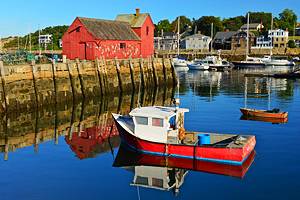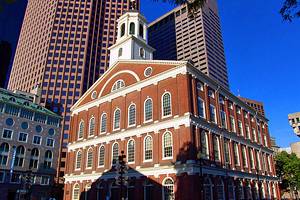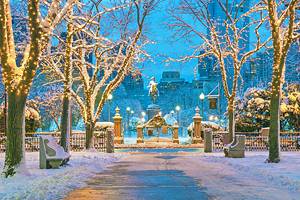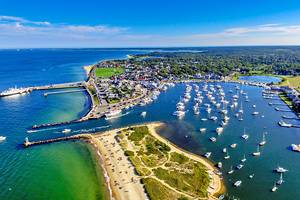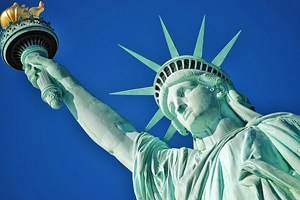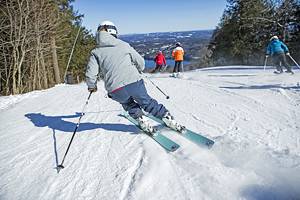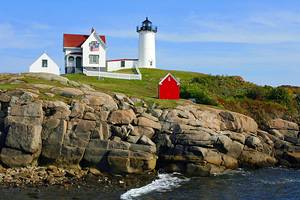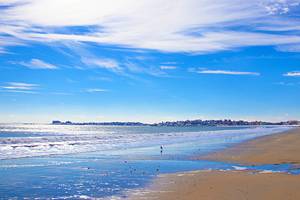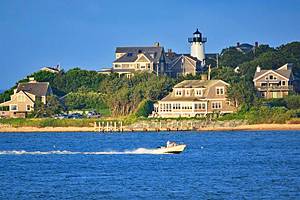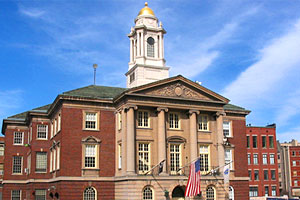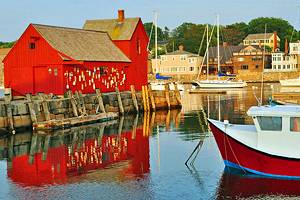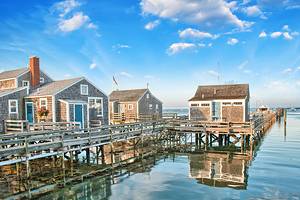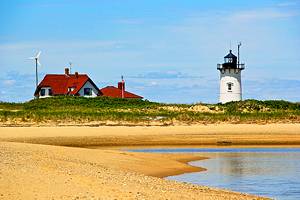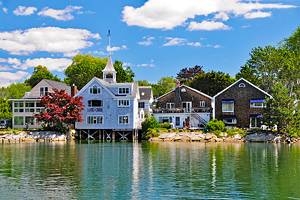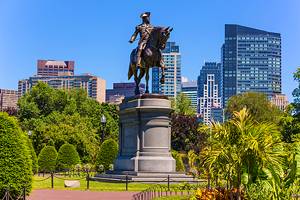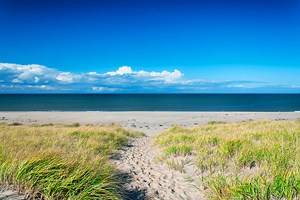Parks in Boston
Boston's parks offer a wide range of experiences, from quiet, shady spots to rest on a hot day to active, vibrant social hubs where you can enjoy free music and cultural events.
Many of Boston's biggest and most popular parks form the Emerald Necklace, a network of green spaces that total over 1,100 acres, encircling the city. This gives tourists plenty of places to relax and recharge while sightseeing in Boston, whether it's a stroll through the Boston Common on your way to Chinatown or a picnic with the swans in Boston Public Garden.
If you want to see the flowers in full bloom, the best time to visit Boston's parks is during May and June, before the full heat of summer hits. Even then, though, these parks offer water features to help you cool off, and a visit in winter is the perfect time to admire the festive lights and perhaps pull on some ice skates for an afternoon diversion.
Whether you're looking for a brief respite or want to keep the kids happy with a visit to the Franklin Park Zoo, you can find the perfect spot with our list of the best parks in Boston.
Public Garden
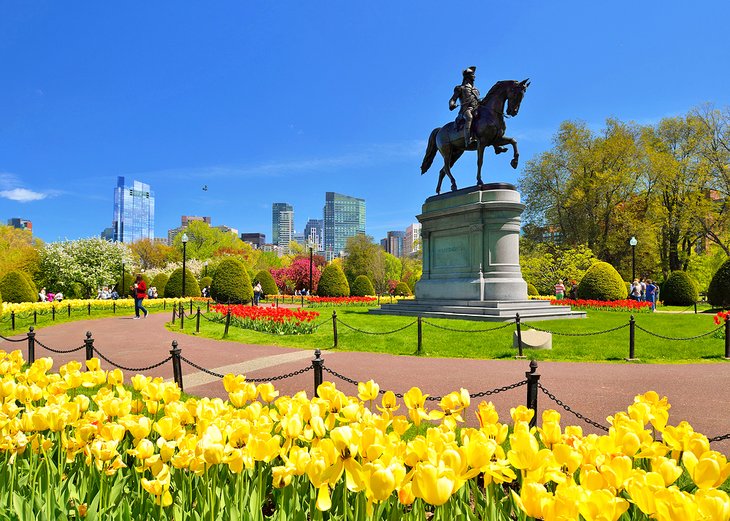
The Boston Public Garden sits adjacent to the Boston Common, with Charles Street separating the sister parks. Established in 1837, this park was the nation's first public botanical garden.
Spring is one of the best times of year to visit the garden, as it springs to life, with plentiful cherry blossoms as early as the end of March and 26,000 tulips blooming each May. Roses and other ornamental flowers grow throughout the park among the trees and lush grass, and this is also a great place to see stunning fall foliage within the city.
The Boston Public Garden is perhaps best known for its four-acre pond, home to a pair of swans as well as other aquatic birds, including mallard ducks. This is also home to the Swan Boats, which are one of to top things to do with kids in Boston. These open-air boats with bench-style seating take a 15-minute ride around the small man-made lake and around Mallard Island, home to nesting grounds for the ducks.
During the spring and early summer, keep an eye out for swan nests along the banks — but keep your distance, too, since these sizable mommies are quite protective of their eggs. The swans, affectionately named Romeo and Juliet, spend their winters at the Franklin Park Zoo.
Among the park's most popular landmarks are the bronze Make Way for the Ducklings statues, created by sculptor Nancy Schön, inspired by the beloved children's book by Robert McCluskey. The story of the Mallard family was set in the Boston Public Garden and has become synonymous with the institution, prompting events like the annual Duckling Day Parade on Mother's Day.
The park is also home to several other statues and monuments, including the George Washington Statue and the Ether Monument. A network of well-maintained paths weaves through the Victorian garden and around the pond, while a suspension bridge crosses the water at its center point.
The Public Garden still operates greenhouses that cultivate more than 80 species of plants used not only here but around the city. Extending more than seven blocks from the center of the park's western side is the Commonwealth Avenue Mall, a broad tree-lined pedestrian path dotted with monuments.
Boston Common
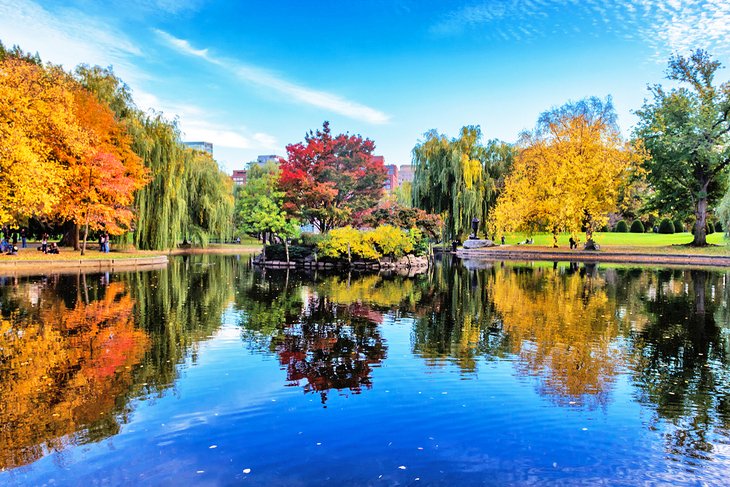
Considered the crown jewel of Boston's Emerald Necklace, the 50-acre Boston Common is the nation's oldest public park, dating back to 1634. Referred to by locals as simply "the Common," it sits in the heart of downtown Boston, flanked by the Chinatown and Back Bay neighborhoods, and has seen centuries of history unfold.
It began as a livestock feeding ground, later serving as a military encampment during the Revolutionary and Civil Wars, and home to victory gardens during the First and Second World Wars. It is also home to the Central Burying Ground, a cemetery with Boston Tea Party participants at rest.
The Common has also been a gathering place for the people of Boston, hosting major Civil Rights rallies and many other peaceful demonstrations, as well as being the starting point for all of Boston's major parades. Tourists who would like to explore the park's history in-depth should go to the Boston Visitor Center, the starting point for Boston Freedom Trail tours and an excellent source of information on current happenings at the park.
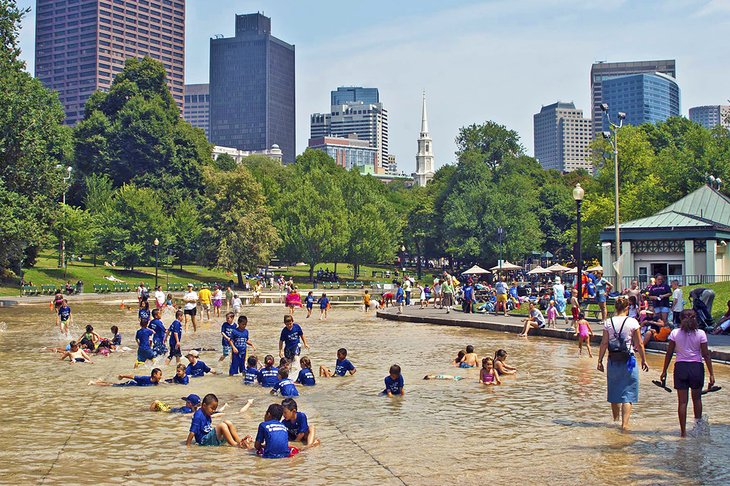
In the summer, visitors will find many family-oriented things to do, including a carousel, playground, and a splash pool called Frog Pond. This park often hosts open-air concerts and performances, with a bandstand and ample green lawn for picnicking and enjoying the lively activity.
Shakespeare on the Common is one of the most popular annual events, a series of free evening performances during July and August. There are ample benches and perches for resting, with trees scattered throughout the park for shade. Winter activities at the Common include ice skating on Frog Pond and the annual tree lighting ceremony.
The Commons can be reached by T (subway) via the green line Boylston Street stop at the southern side, or the red and green line Park Street stop on the northeast corner. Beneath the Commons, there is also an underground parking garage with an entrance on Charles Street, although drivers will find the rates quite steep.
Rose Kennedy Fitzgerald Greenway
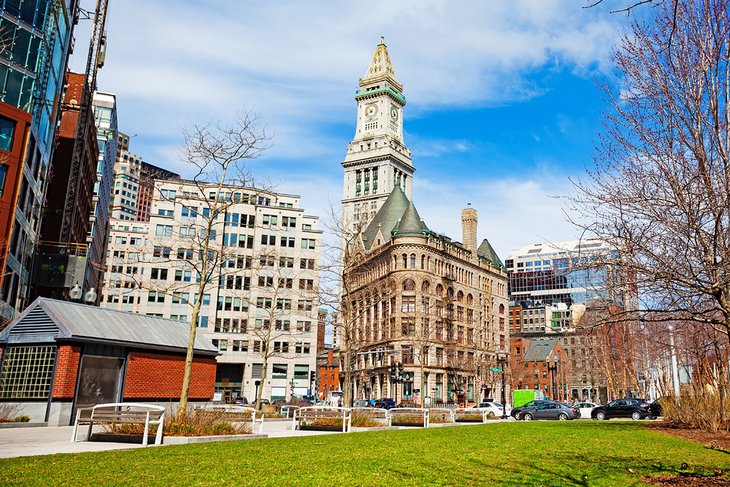
For residents of the North End and surrounding areas, the Rose Kennedy Fitzgerald Greenway is far more than just a park — it symbolizes an epic transformation from the aging cement eyesore of the former Central Artery to a stunning green space. This project, part of Boston's "Big Dig," was officially completed in 2008, providing a 1.5-mile-long stretch of parkland that totals 17 acres between downtown Boston and Boston Harbor.
This park is a favorite for all ages, but kids adore it for the Greenway Carousel, a one-of-a-kind creation inspired by drawings made by local children. Newburyport artist Jeff Briggs brought the drawings to life to create a whimsical ride that is also accessible to riders with disabilities. Kids, as well as parents, also love the numerous fountains that were designed for function as well as beauty, inviting visitors to cool off in the spray.
The Greenway also offers public art exhibits, many of which are interactive. These installations change periodically and encompass a wide variety of cultures and media. Visitors could easily spend the good part of a day exploring the park, with plenty of food trucks and shady places to rest.
Those visiting on weekend mornings will want to stop by Haymarket, Boston's open-air produce market. Nearby attractions also include the shops and food stalls at Quincy Market and Faneuil Hall, as well as the New England Aquarium. If you venture into the North End for some scrumptious Italian baked goods, head to Modern Pastry, where the lines are a little shorter than at other bakeries but the goodies are some of the best in the city.
Back Bay Fens
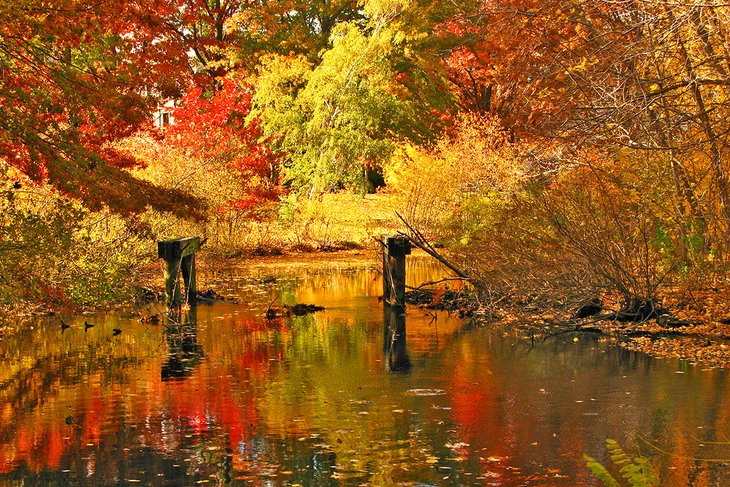
The Back Bay Fens is the work of landscape architect Frederick Law Olmstead, who transformed an area flooded with stagnant saltwater into a safe and functional green space. This beloved park is the namesake for both the neighborhood and the nearby Fenway Park, the historic home stadium of the Boston Red Sox.
There is a modest-sized children's playground appropriately named Mother's Rest, and the World War II Memorial is perfect for a contemplative stop. This is located in the central part of the park next to the Kelleher Rose Garden, a lovely space with rose-trellised arches and a fountain.
The southern end of the park has a track that runs around Clemente Field, a multi-purpose athletic field. This lovely wetland area is also an excellent place for bird-watching, with native fowl like great blue heron, indigo bunting, eastern kingbird, wood duck, and red-tailed hawk.
The Fens has several historic features, including a Japanese Temple Bell made in 1675, an 1897 stone roadhouse named the "Duck House," the Westland Gate erected in 1905, and the neoclassical Fire Alarm Office completed in 1925.
The Fens is also home to Boston's oldest surviving World War II Victory Garden, established in 1941, still operating today as a community garden in the northwestern section of the park off Boylston Street. Visitors can learn more about the park and obtain maps at the Shattuck Visitor Center, home of the Emerald Necklace Conservancy headquarters.
Franklin Park
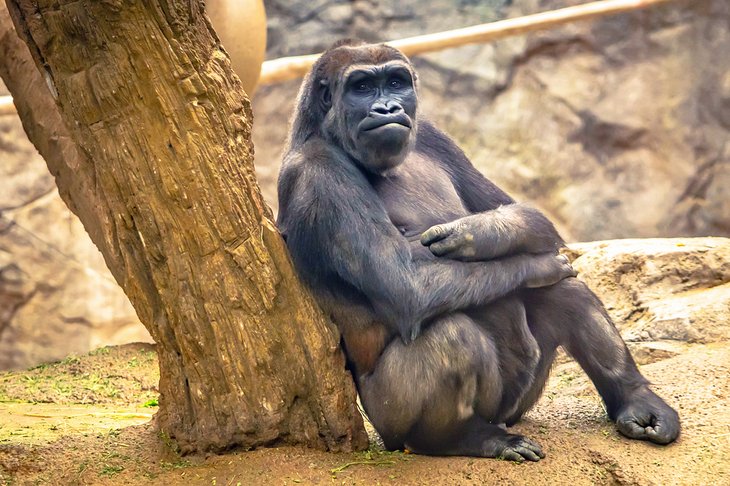
Franklin Park is Boston's largest open space, located south of Downtown Boston within the Jamaica Plain, Roxbury, Roslindale, and Dorchester neighborhoods. Another of Frederick Law Olmstead's green masterpieces, this 485-acre park was designed in the 1890s.
Franklin Park's most popular tourist attraction is the Franklin Park Zoo, a 72-acre facility that opened in 1912. There are an astounding number of animals in residence, with family favorites like the African lion, Masai giraffe, two-toed sloth, kangaroo, and lemur, among many others. There is also a variety of exhibits, including a butterfly house, two aviaries, and a kids' farm to get up close with small farm animals.
The park is also home to a wide variety of sports facilities, most notably an 18-hole golf course, which is the oldest public golf course in the country. Other facilities include basketball and tennis courts and fields for soccer, rugby, baseball, and lacrosse.
During the summer, visitors can enjoy open-air theater performances at the Playhouse in the Park. Other points of interest include Ellicott Arch, Scarboro Pond, the Bell Tower, and several playgrounds.
Arnold Arboretum
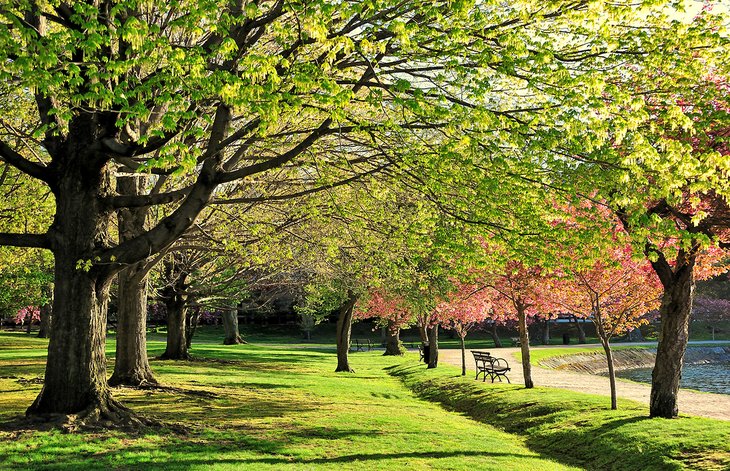
Located in Boston's Jamaica Plain and Roslindale neighborhoods, the grounds of the Arnold Arboretum cover 281 acres, ribboned with paths, many of which are fully accessible to wheelchairs and strollers. Founded in 1872, the park is a National Historic Landmark and another work of Frederick Law Olmstead.
The park is maintained by Harvard University, which uses it as a living classroom, and they also run the visitor center, which provides educational exhibits and public workshops.
As expected, the arboretum is home to a wide variety of trees that thrive in this southern New England climate, including many varieties of maple, crabapple, hemlock, and the extremely rare Franklin tree. In addition, the park has a wide variety of deciduous and coniferous shrubs, vines, and perennial flowering plants, including lilacs, azaleas, and a massive rhododendron collection with some specimens dating back to 1886.
One of the park's most fascinating collections consists of its smallest trees: the Bonsai & Penjing Collection. The most coveted are the five Hinoki cypress bonsai, which are very rare, and there is a total of 36 expertly tended specimens.
The arboretum is free to the public and open from dawn to dusk year-round; leashed dogs are welcome. Free docent-led tours of the park's highlights are available on weekends.
Address: 125 Arborway, Boston, Massachusetts
Castle Island & Fort Independence Park
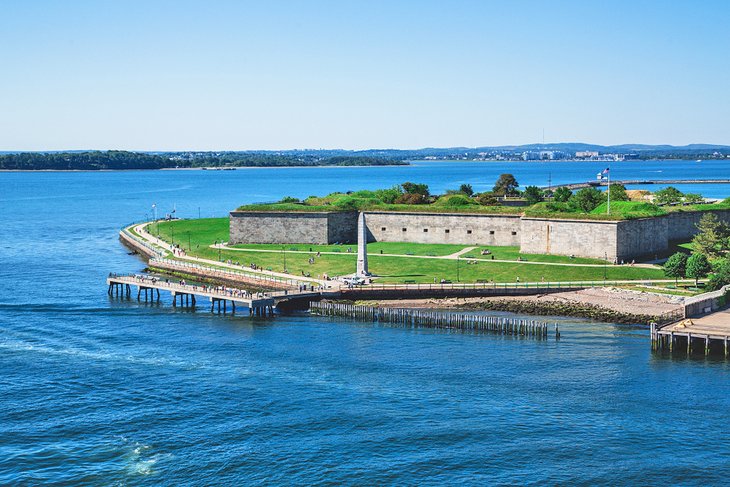
Located in South Boston (known as "southie" to locals), Castle Island and Fort Independence Park are the most popular section of the Boston Harbor National Recreation Area. The park encompasses 22 acres at the tip of a man-made peninsula in Boston Harbor, where the island connected to the mainland in 1928.
Its centerpiece is the classic pentagonal fortress, Fort Independence. The first fortification was built here in 1634, with the version you see today completed in 1851. Visitors can participate in free 30-minute tours of Fort Independence on weekends.
Castle Island is home to two beaches, which face Pleasure Bay, an area protected from the open ocean by the Head Island Causeway. These beaches share rest and bathing facilities, including showers, and there is a playground just behind the larger of the two beaches.
The Harborwalk circles the perimeter, providing stunning views of the water, city, and surrounding islands; kids will particularly enjoy watching airplanes take off from nearby Logan Airport.
The Harry McDonough Sailing Center operates from a dock between the beaches, and on the opposite side of the island, there is a fishing pier just beyond the Clipper Ship Monument to Donald McKay, a granite obelisk. There is a good takeout restaurant near the parking area, although this is also a popular place to bring a picnic.
Christopher Columbus Waterfront Park
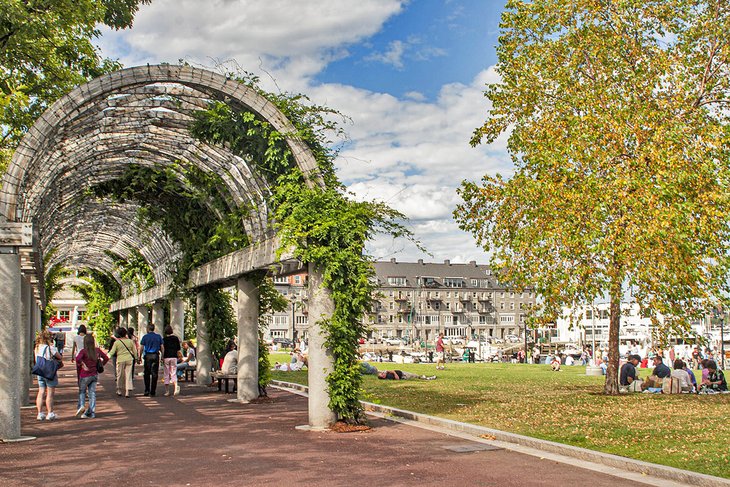
Long before the Greenway sprang from the Central Artery, the Christopher Columbus Waterfront Park was the North End's original family park. Overlooking Boston Harbor, this park features vine-covered trellises that provide shade along the central pedestrian path. When not covered in lush leaves, this massive archway is decorated in lights to celebrate the winter holidays.
The playground is located in the northern corner of the park, loved by kids for its "crow's nest," which affords little ones great views of the boats coming in and out of Boston Harbor. Next to the playground is the Massachusetts Beirut Memorial.
This park is also home to the Rose Kennedy Rose Garden, a lovely space with a fountain and plenty of shaded benches. The park hosts numerous events and festivals throughout the year.
Charles River Esplanade
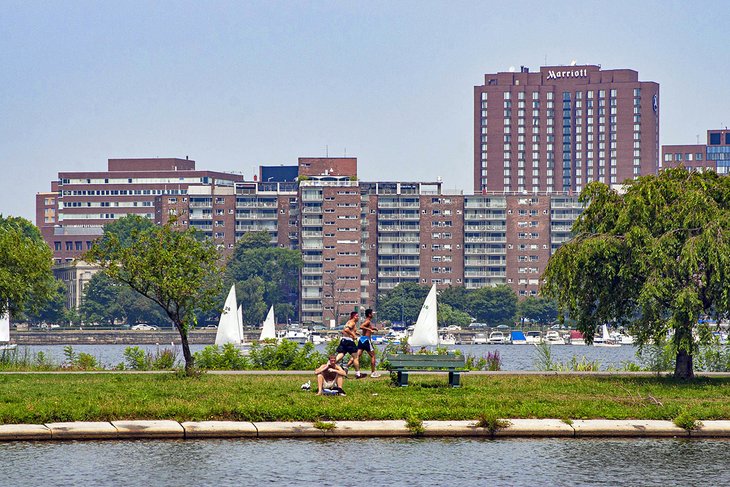
Originally developed as the Boston Embankment in 1910, this three-mile stretch along the Charles River runs from the Boston University Bridge to the Museum of Science. The Boston Esplanade contains a total of 17 miles in paths that are used for running, rollerblading, cycling, and, of course, riverside strolls. The park can be accessed via any of several footbridges that traverse Storrow Drive.
This park is home to several playgrounds and sports fields, as well as boat launches, but its best-known feature is the Hatch Shell Bandstand. As long as the weather permits, the Hatch Shell hosts free films and musical performances for the public. The most iconic of these performances is the Fourth Of July concert hosted by the Boston Pops.
Read More: Hiking & Walking Trails near Boston
Map of Parks in Boston
Boston - Climate Chart
| Average minimum and maximum temperatures for Boston, MA in °C | |||||||||||
| J | F | M | A | M | J | J | A | S | O | N | D |
| 2 -6 | 4 -4 | 8 -1 | 13 5 | 19 10 | 25 15 | 28 18 | 27 18 | 23 14 | 17 8 | 11 3 | 6 -2 |
| PlanetWare.com | |||||||||||
| Average monthly precipitation totals for Boston, MA in mm. | |||||||||||
| 100 | 84 | 98 | 91 | 82 | 82 | 78 | 86 | 88 | 96 | 101 | 95 |
| Average monthly snowfall totals for Boston, MA in cm. | |||||||||||
| 30 | 31 | 18 | 3 | 0 | 0 | 0 | 0 | 0 | 0 | 3 | 21 |
| Average minimum and maximum temperatures for Boston, MA in °F | |||||||||||
| J | F | M | A | M | J | J | A | S | O | N | D |
| 36 22 | 39 24 | 46 31 | 56 41 | 67 50 | 77 59 | 82 65 | 80 64 | 73 57 | 62 46 | 52 38 | 42 28 |
| PlanetWare.com | |||||||||||
| Average monthly precipitation totals for Boston, MA in inches. | |||||||||||
| 3.9 | 3.3 | 3.9 | 3.6 | 3.2 | 3.2 | 3.1 | 3.4 | 3.5 | 3.8 | 4.0 | 3.7 |
| Average monthly snowfall totals for Boston, MA in inches. | |||||||||||
| 12 | 12 | 6.9 | 1.1 | 0 | 0 | 0 | 0 | 0 | 0 | 1.3 | 8.1 |


